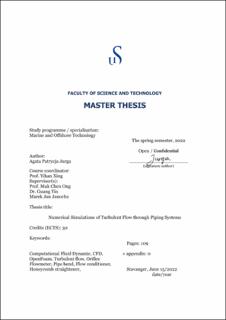| dc.description.abstract | Piping systems have a wide range of applications across many different industries. Pipelines are essential infrastructure in the offshore oil & gas installations. One of the key challenges when operating complicated piping systems is accurate measurement of the flow characteristics required for example to optimize the process or maintain the flow assurance. The pipe fittings such as elbows, bends, and reducers introduce disturbance in the flow and distort the velocity profile downstream in the pipe which adversely affects the accuracy of flowmeter devices. To counteract these undesired effects, various types of flow conditioners can be installed between the source of flow disturbance and the measuring device. In this thesis, the behavior of turbulent flow passing through three different components of the piping systems is investigated: an orifice plate, a 90-degree pipe bend and thereafter a honeycomb straightener. The Reynolds numbers in present analyses range from 1×104 to ≤ 2×105. First, a validation study of eight different Reynolds-Averaged Navier–Stokes (RANS) turbulence models is performed to choose the model that gives the best prediction of the fluid flow through an orifice flowmeter. Among the benchmarked models, the Explicit Algebraic Reynolds Stress Model (EARSM) shows the best agreement with the experimental validation data. In the second part, the validated turbulence model is used to study the effects of different pipe bend geometries and Reynolds number (Re) on the flow behavior. Based on further numerical simulations of the flow through the pipe bend, it is found that for small curvature radiuses (Rc/D<\ 2), the velocity profiles are highly deformed and separation bubble develops behind the bend. Finally, the influence of a new honeycomb straightener design on the flow quality is investigated downstream of the 90-degree pipe bend. The case of pipe bend with Rc/D=2 is employed to that end. It is concluded that the optimum effectiveness in eliminating the swirl and improving the velocity profile pattern is reached for the honeycomb straightener located at the minimum distance from the bend outlet of Lb=5 and thickness of t=0.5. Furthermore, a detail description of the investigated flow fields are presented in terms of axial velocity profiles, turbulence intensity, velocity perturbation, pressure, vortex formations, secondary flow regions, streamline patterns and swirl intensity. | |
